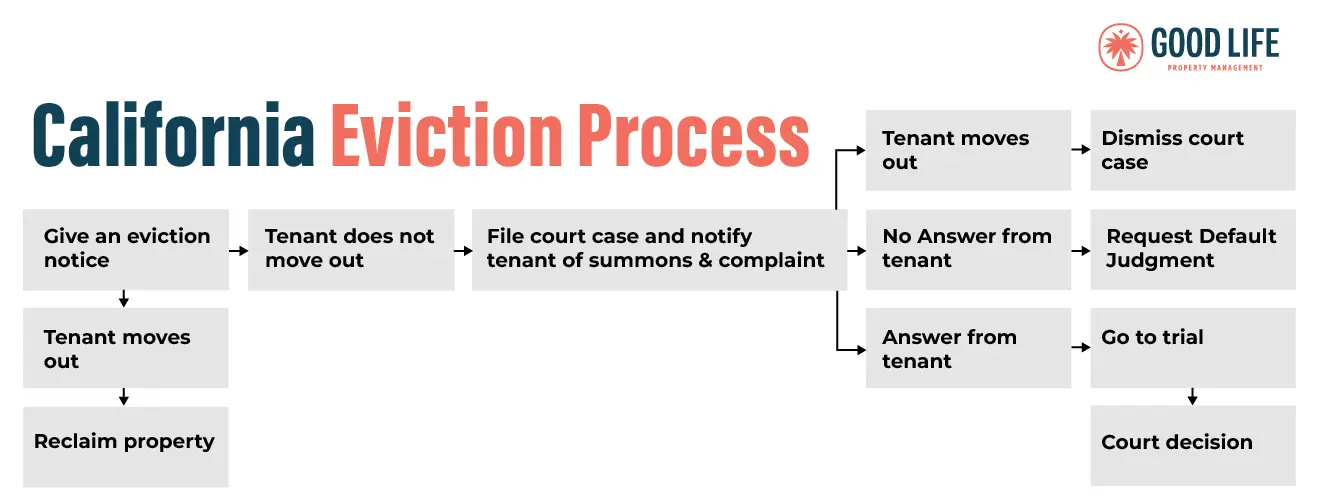The California Eviction Process: Cost & Steps UPDATED 2025
Evicting a tenant in California can be a complex and resource-intensive process. From serving eviction notices to navigating through legal proceedings, each phase requires meticulous adherence to state laws and regulations. In this comprehensive review, we will dive into the steps of the eviction process in California and provide insights into the expenses landlords may encounter along the way.
The dreaded eviction is a nightmare for both tenants and landlords. Not only is the eviction process lengthy and expensive, but it also involves months of back and forth with attorneys, the court, and your tenants. In legal terms, evictions are referred to as unlawful detainers.
Many property owners aren’t fully aware of the costs and steps involved in an eviction. In this article, we’ll review the different costs associated with the process and what steps are required.
Reasons For Eviction in California
The process of evicting a tenant in California has strict legal guidelines that are designed to ensure fairness and protect the rights of both landlords and tenants. If you find yourself in a situation where you wish to remove a tenant from your property, you must have a valid and legally recognized reason for the eviction.
Before we dive into how to evict someone, let’s take a look at reasons why you’d want to evict someone.
At-Fault Evictions
- Consistently late rent.
- Incomplete rent payments or non-payment of rent.
- Breach of the lease or rental agreement, with no intent to rectify the issue.
- Causing damage to the property.
- Disrupting the peace and well-being of other tenants or neighbors.
- Use of property for illegal activities.
- When the landlord intends to move back into their property.
- When the landlord wants to move a family member into the property.
No-Fault Evictions
- They continue to stay in the property after the lease has expired.
- The rental agreement is terminated after proper notice is given.
- Based on discriminatory factors such as race, sex, religion, national origin, marital status, sexual orientation, number of children, job, physical or mental disability, or if the tenant is receiving public assistance.
- As retaliation against the tenant for filing a complaint regarding maintenance issues, code violations, emergency service calls, or any other action taken in good faith.
How to Evict a Tenant in California
- Give a Notice
- Start a Court Case
- Ask for Trial date or default judgment
- Go to Trial
- After the judge decides
Before the Eviction
Attempt to Negotiate
Before beginning a court eviction, attempting reconciliation is worth a shot. Even though the fight to get possession of your property can be an emotional one, preventing it can save both parties money and time.
“Many landlords lose sight of the true end goal because they get frustrated that they are in this situation. They want the eviction on the tenant’s record, no matter the cost,” said Natalia Vanni. “But the main goal of an eviction is to get your property back. If this can be achieved without starting the eviction process, we strongly recommend it.”
Before you start an eviction, you can offer your tenant an alternative as a last-ditch effort to get them to vacate. This could include giving them a set deadline to vacate or requesting they pay any outstanding rent or any fees you have incurred by filing the initial paperwork.
Unfortunately, not all tenants will want to negotiate. They may think you will not proceed with the eviction, so they stand their ground. After exhausting all your other options, beginning the eviction process might be your last option.
Steps of Eviction
The timeline of an eviction varies but often takes 3 to 4 months minimum to complete from start to finish. According to the California Courts self-help guide, the eviction process can take 30-45 days, or longer. The time starts on the date that the eviction court forms are delivered to your tenant.
Now that we know the eviction timeline, let’s dive into the steps of the eviction process.
1. Post The Notice
Different types of Eviction Notices
The first step is to serve your tenant with the initial Notice, which will inform them of the issue and what is required of them to resolve it. You must have a legal reason for evicting the tenant, such as nonpayment of rent, lease violation, property damage, nuisance, or illegal use. The different types of notices are as follows:
- 3-Day Notice to Pay Rent or Quit – for failing to pay rent.
- 3-Day Notice to Cure or Quit/Perform a Covenant or Quit – for curable violations, such as not maintaining the rental unit in a clean and sanitary manner or for having unauthorized pets.
- 3-Day Notice to Quit – for incurable violations, such as illegal activity, excessive property damage, criminal activity, etc.
- 30/60 Day Notice to Quit – for termination of the lease agreement. This is most commonly used for terminating month-to-month tenancies.
The type of notice given to the tenant depends on factors such as the terms of the lease agreement, whether the property is Section 8 subsidized, and so on. For more information on the different types of eviction notices, check out the California Courts website.
Important note: make sure the Notice you’re using includes everything required by California law. Mistakes or missing information in the Notice may cause you to lose the case.

Serve the Notice
After you write the appropriate Notice with all necessary requirements, you must serve it to the tenant. California courts allows three options to serve tenants:
- Hand deliver the Notice to the tenant.
- Give the Notice to an adult who will give the Notice to the tenant and mail a copy of the Notice.
- Post the Notice on the home where the tenant lives and mail a copy of the Notice.
For more information on how to serve an eviction notice, visit the California Courts Deliver the Notice webpage.
Be sure to conform to all the service requirements, such as mailing the Notice on the same day of posting the Notice. If you are working with your attorney, they can assist you with this. Make a copy of the Notice for your records and fill out a proof of service. This will be important to record, should the case escalate to the courts.
2. File With The Court
- The lease or rental agreement and any written changes the tenant agreed to;
- The eviction notice you gave your tenant;
- Written proof your tenant was given the notice;
- Any other important communications the attorney should be aware of.
Then, you will need to fill out the following court forms:
Ask your attorney to help you file these forms with the court. Make copies of everything submitted and post the Summons and Complaint to your tenant’s home. Filing these forms with the court can cost anywhere between $240-$450, excluding attorney fees.
Be sure to check with your local courts to see if there are any other forms you need to submit.
3. Dismiss, Default Judgment, or Trial
How to Serve an Eviction Summons and Complaint to a Tenant
Once you have successfully filed the Summons and Complaint and other necessary files with the court, you must “Serve the Papers” to your tenant. Unlike eviction notices, however, you cannot personally serve the Summons and Complaint to your tenant. Instead, you must enlist the help of an adult individual, commonly known as a “server,” to handle the delivery.
Your server must be 18 years of age or older and cannot be directly involved in the eviction case. Your server can be someone you know and trust, a sheriff, or a professional process server.
The assigned server’s primary responsibility is to locate your tenant and deliver a copy of the filed papers to them personally. It is essential for the server to record the address where the documents were handed to the tenant, along with the date and time of the service. This information is required to complete a “Proof of Service of Summons” form, which you must file with the court.
If the server cannot find the tenant(s), then you need permission from the court to serve by posting.
After Serving the Eviction Summons and Complaint
Effective January 1, 2025, AB 2347 extends the period tenants have to respond to an Unlawful Detainer Summons from 5 business days to 10 business days. The tenant has 10 business days—minus Saturdays, Sundays, and Court Holidays—to submit their Answer. This additional time requires landlords to account for longer timelines in the eviction process.
There are three scenarios that can take place, each with different next steps:
The tenant moves out or you come to an agreement, then the court case is dismissed
If your tenant moves out or you two come to an amicable agreement, you can file forms to dismiss the eviction case.
The tenant does not respond and does not move out, then you can request a Default judgment
If the tenant did not respond by the deadline, you can ask for a default judgment. Once you have a default judgment from the court, you can ask for a Clerk’s Judgment of Possession to get your property back as soon as possible. In order to do this, you will need to ask for and file the following forms:

The tenant submits a response, then you go to trial
4. Decision
The judge will make a decision after hearing both sides. They will either side with you and the tenant will vacate, or they will side with the tenant and the tenant will remain in your property.
If you win the case, a Writ of Possession will be issued. Then the sheriff will post this notice to the tenant five to 15 days after judgment. Finally, the sheriff lockout will occur approximately one week later. You should be prepared to meet the sheriff for the lockout and hire a locksmith. They will change the locks so the tenant cannot access the property.
The judge may also order your tenant to pay back rent, damages, penalties, and costs (attorney and court fees) related to the case. If your tenant wins, you may have to pay their costs associated with the case.
Cost Breakdown
There are a few different types of fees involved in an eviction. In total, an eviction will likely cost you around $3,000-$4,000 (not including lost rent).
Attorney Fees
You’ll need to hire an attorney for any eviction proceedings. They know the law much better than you do and can provide valuable information throughout the process. Hiring an attorney will cost you a minimum of $500, but it will more likely be closer to $2,000, should the enter eviction process play out.
Court Fees
The first step of any eviction process is to file a claim with a court. Depending on your location, this fee will vary. In San Diego, you can expect to spend between $250 to $450 on the initial filing depending on the total case amount.
Lost Rent
This is one of the biggest and most frustrating costs to endure during an eviction. Evictions often take months to complete, which leads to months of rent your tenant isn’t paying and could add up to thousands of dollars in losses for you.
This problem has only worsened since the start of the pandemic. Multiple eviction moratoria have been enacted throughout the county, resulting in a backlog of cases for the San Diego courts.
“We are seeing each step of the eviction process take three times longer than it used to,” said resident property manager Bryce Baker. “An eviction we filed in July of this year [2022] is stuck in the Summons and Complaints phase whereas, pre-pandemic, we could expect the entire process to be complete by now.”
Even if you win the case, owners typically reclaim only 40-50% of lost rent. When an eviction goes to collections, the collection company will negotiate the amount owed with the tenant directly, often for a lower amount than is technically owed. From there, collection companies retain 50 to 60% of the collected amount, leaving the owner with only that 40 to 50%.
Property Damages
Unfortunately, along with nonpayment of rent usually comes property damages. Once a tenant has been served, they will lose interest in maintaining your property. You’ll already have your standard turnover costs once the tenant finally vacates, but these costs will likely be higher than usual after an eviction. Keep in mind that you can use their security deposit for these damages and for unpaid rent.

Preventing an Eviction
Finding a great tenant at the start can help you avoid messy legal situations. The best way to prevent the need for an eviction is thorough tenant screening. Create a written rental criteria to stick to.
You should always require the following from an applicant:
- Government-issued photo ID
- Income verification
- Landlord contact info for the last 3 years
Once you’ve received a completed application, run a credit and background check on the applicant. Credit history can be a big indicator of potential issues.
You can also list common reasons to deny an applicant, such as having a credit score below 624, previous eviction judgments, collections from former landlords, negative landlord references, and non-discharged bankruptcies.
Even a great screening process doesn’t guarantee you won’t encounter problems with a tenant. The most common reasons for an eviction are nonpayment of rent or what’s called a holdover tenant. These are tenants who refuse to vacate once their lease ends.
As we mentioned previously, it’s best to negotiate with your tenant before proceeding with an eviction. “Evictions should only be utilized when negotiating is not possible and there is no other choice,” said resident property manager Brent Zimmer. “It’s painful for all parties involved, especially the [property] owner.”
If you found this article helpful, follow us on social media. We post daily tips to help you manage your own rental property:
Steve Welty
Subscribe to our Weekly Newsletter
Join the 5k+ homeowners receiving Local Law Updates and Landlord Tips. Delivered to your inbox every Saturday at 6am PST.
Share this:
Get in touch with us:

Pro Services
Tired of headaches?
We got you covered.
Choose Your Next Step
Good Life Blogs
We believe that education is empowering.

SB 52: California May Ban AI Rent Pricing Tools
California’s SB 52 could ban landlords from using AI to set rent prices. Learn how this bill may impact your rental business and what actions you can take.

Trash Collection Fees Coming to San Diego Rental Properties
Trash collection fees are coming to San Diego landlords. Learn who’s affected, how much it will cost, and how to stay compliant.

How to Turn Vacant Rental Properties into Tax Deductions
Learn how to turn your rental property’s vacancy into potential tax deductions. Discover the rules, strategies, and tips landlords need to know.







